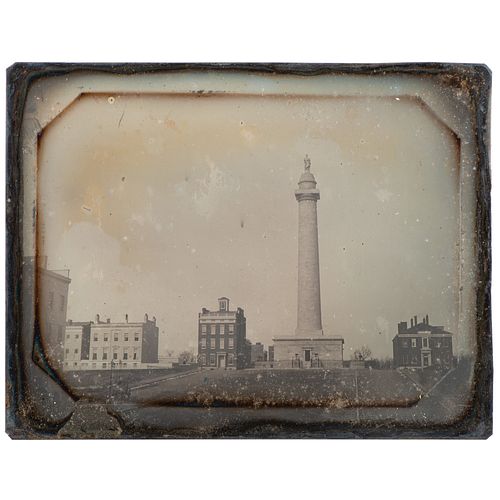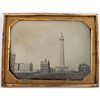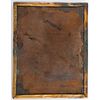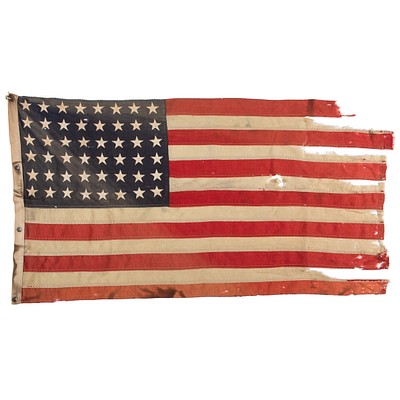Half Plate Daguerreotype of the Washington Monument, Baltimore, Maryland, Possibly by John Plumbe, Jr.
About Seller
6270 Este Ave.
Cincinnati , OH 45232
United States
With offices in Cincinnati, Cleveland and Denver, Cowan’s holds over 40 auctions each year, with annual sales exceeding $16M. We reach buyers around the globe, and take pride in our reputation for integrity, customer service and great results. A full-service house, Cowan’s Auctions specializes in Am...Read more
Two ways to bid:
- Leave a max absentee bid and the platform will bid on your behalf up to your maximum bid during the live auction.
- Bid live during the auction and your bids will be submitted real-time to the auctioneer.
Bid Increments
| Price | Bid Increment |
|---|---|
| $0 | $25 |
| $500 | $50 |
| $1,000 | $100 |
| $2,000 | $250 |
| $5,000 | $500 |
| $10,000 | $1,000 |
| $20,000 | $2,500 |
| $50,000 | $5,000 |
| $100,000 | $10,000 |
About Auction
Jun 26, 2020
Cowan's Auctions is delighted to present the June 26 American Historical Ephemera and Photography Auction, including 55 lots devoted to the African American experience, over 175 lots dating from the Civil War Era, and more than 60 lots documenting life in the American West. Cowan's Auctions dawnie@cowans.com
- Lot Description
Half Plate Daguerreotype of the Washington Monument, Baltimore, Maryland, Possibly by John Plumbe, Jr.
Anonymous, half plate daguerreotype, n.d., ca 1845. Presents a striking view of the Washington Monument in Baltimore, Maryland, with three identified Mount Vernon Place establishments visible in the background. Possibly attributed to prolific daguerreotypist John Plumbe, Jr., (1809-1857), active in Baltimore beginning in 1843.
Compositionally anchored by the verticality of the Washington Monument, this daguerreotype was captured from the east side of Charles Street looking north. Baltimore’s monument to George Washington, one of several public displays of reverence for the history of the city, was completed in 1829, and Mount Vernon Place, the surrounding neighborhood, was subsequently developed during the 1830s and 1840s, a time marked by rapid economic growth and prosperity for the city. The three buildings present here are the Howard House (built 1830), the Greenway House (built 1835), and the Tiffany-Fisher House (built 1842). Mount Vernon Place was entirely built up by 1848, which dates this image to somewhere between 1842 and 1848, a suggestion reinforced by the visible architectural evidence and the condition of the plate and its packaging.
The exact authorship of the daguerreotype is less clearly defined, although several clues taken together suggest John Plumbe, or at least to his Baltimore gallery, which was managed by Jacob Shew. Plumbe's was the major daguerreotype establishment in Baltimore in the mid-1840s, and his interest in documenting the city's monumental landmarks is supported by the existence of several Plumbeotype views (lithographic reproductions after Plumbe's original plate) of the Washington Monument taken from a different viewpoint, as well as a Plumbe half plate image of another major public memorial, the Battle Monument, housed in the collection of the Library of Congress. Further, an article about Plumbe's Gallery in the Baltimore Republican & Daily Argus newspaper of January 3, 1846, mentions "a view of the Washington Monument, taken from Charles Street" that was on display in the gallery during the writer's visit. While this reference is not conclusive, it does accurately describe the daguerreotype offered here, as suggested by photographic historian William F. Stapp. Attribution to Charles H. Fontayne (1814-1858) is also possible, given his activity in Baltimore during the mid-1840s, his technical prowess, and his use of larger plate cameras, though the supporting evidence is less robust.
A rare and visually distinct view of Baltimore during a period of remarkable growth and civic cultivation.Uncased, under brass mat and preserver, with yellowish area to upper left corner. Plate with minor dust adhering, one short scratch at upper left corner. While the original glass is present, it is discolored and spotted and should be replaced.Condition
- Shipping Info
-
Buyers are required to pay for all packing, shipping and insurance charges. Overseas duty charges are the responsibility of the successful Bidder. Be aware that for larger and/or valuable items, shipping charges can be substantial. - If there is no shipping amount on listed your invoice, you will need to make arrangements to pick up or ship your purchase through an alternative shipping company. Our shipping department can be contacted at 513.871.1670 (ext. 219) or email shipping@cowans.com. - Shipping charges include insurance for your order while in transit. If you have private insurance we will adjust your charge to include only packing and shipping. - Please allow 14 – 21 days after payment to package and ship your purchase as carefully as possible.
-
- Buyer's Premium



 EUR
EUR CAD
CAD AUD
AUD GBP
GBP MXN
MXN HKD
HKD CNY
CNY MYR
MYR SEK
SEK SGD
SGD CHF
CHF THB
THB













